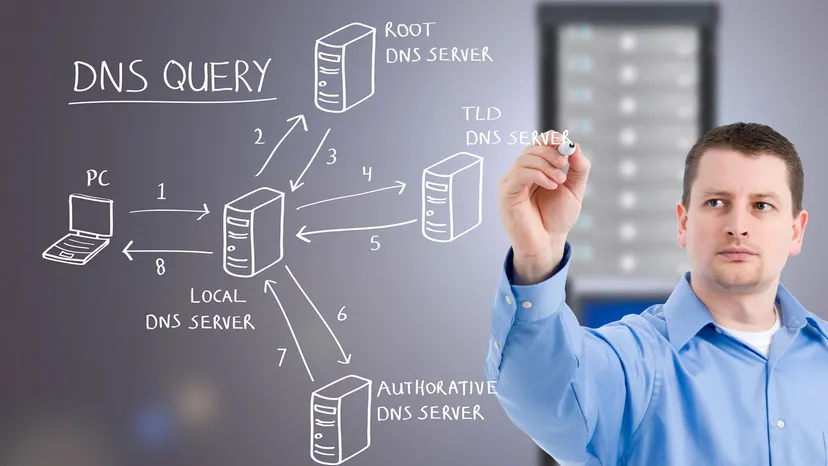Understanding DNS: The Phonebook of the Internet
 Chinnayya Chintha
Chinnayya Chintha
The Domain Name System (DNS) is a critical component of the internet, enabling users to access websites using easy-to-remember domain names instead of numerical IP addresses. Without DNS, navigating the web would require memorizing strings of numbers for every website you visit. This article provides a comprehensive yet straightforward guide to understanding DNS, its key concepts, and how it works.
What is DNS?
Imagine the internet as a vast network of interconnected devices. Each device has a unique identifier known as an IP address, such as 192.168.1.1 or 2607:f8b0:4005:805::200e (IPv6). DNS acts as the phonebook of the internet, translating human-readable domain names like google.com into these machine-friendly IP addresses, allowing computers to locate and communicate with each other.
How DNS Works
When you type a web address like www.example.com into your browser, DNS follows a series of steps to resolve the domain name into an IP address:
Browser Query:
Your browser checks its local cache to see if it already knows the IP address for
www.example.com.If not, it sends a request to your configured DNS server (e.g., Google DNS at
8.8.8.8).
Contacting the Root Server:
- The DNS server queries a Root Server, which is the starting point for DNS resolution. The Root Server doesn’t know the exact IP address but directs the query to the appropriate Top-Level Domain (TLD) server, such as
.comor.org.
- The DNS server queries a Root Server, which is the starting point for DNS resolution. The Root Server doesn’t know the exact IP address but directs the query to the appropriate Top-Level Domain (TLD) server, such as
Querying the TLD Server:
- The TLD server narrows the search and points to the authoritative DNS server responsible for the domain name (e.g.,
example.com).
- The TLD server narrows the search and points to the authoritative DNS server responsible for the domain name (e.g.,
Reaching the Authoritative DNS Server:
- The authoritative server provides the specific IP address for
www.example.com(e.g.,93.184.216.34).
- The authoritative server provides the specific IP address for
Returning the IP Address:
- The DNS server sends the IP address back to your computer, enabling your browser to connect to the website.
This entire process typically takes milliseconds.
Key DNS Records
DNS records store information about a domain. Some of the most common types include:
1. A-Records (Address Records)
Maps a domain name to an IPv4 address.
Example:
Domain:
example.comA-Record:
192.0.2.1When users visit
example.com, DNS resolves it to192.0.2.1.
2. CNAME Records (Canonical Name Records)
Points one domain name to another domain name.
Example:
Subdomain:
blog.example.comCNAME:
pages.example-host.comVisitors to
blog.example.comare redirected topages.example-host.com.
3. Reverse DNS (rDNS)
Resolves an IP address back to a domain name.
Used for:
Email server verification to prevent spam.
Network troubleshooting.
Example:
IP:
93.184.216.34Reverse DNS:
example.com.
Configuring DNS Settings
If you own a domain, you may need to configure DNS settings for website hosting or email. Here are some common configurations:
Updating A-Records:
Log in to your domain registrar (e.g., GoDaddy, Namecheap).
Go to the DNS management section.
Add or update the A-Record:
Name:
@(for the root domain).Value:
192.0.2.1(your server’s IP address).
Adding a CNAME Record:
Use it for subdomains or redirection.
Example:
Name:
blogValue:
pages.example-host.com.
Reverse DNS:
Usually configured by your hosting provider.
Provide them the desired domain name for a specific IP address.
Troubleshooting DNS Issues
DNS problems can disrupt website access. Here are common troubleshooting steps:
1. Check DNS Propagation:
DNS changes take time to propagate, usually up to 48 hours.
Use tools like DNS Checker to monitor changes globally.
2. Use Command-Line Tools:
nslookup example.com: Displays the IP address of the domain.dig example.com: Provides detailed DNS resolution information.
3. Flush DNS Cache:
Clear your local DNS cache to ensure you’re using the most up-to-date information.
Commands:
Windows:
ipconfig /flushdnsMac:
sudo dscacheutil -flushcache
Real-World Examples
Example 1: Hosting a Website
You’ve purchased a domain example.com and want to point it to your web hosting server with the IP 192.0.2.1.
Configure an A-Record for
example.com:Name:
@Value:
192.0.2.1.
Example 2: Redirecting a Subdomain
You’re using a blogging platform and want blog.example.com to redirect to your hosted blog at pages.example-host.com.
Add a CNAME record:
Name:
blogValue:
pages.example-host.com.
Conclusion
DNS is the backbone of the internet, making it possible for humans to use friendly domain names instead of IP addresses. By understanding how DNS works, you can effectively manage domain configurations, troubleshoot issues, and ensure smooth internet navigation. Whether you’re a website owner or an IT professional, mastering DNS concepts like A-records, CNAMEs, and reverse DNS is invaluable for managing online resources.
Subscribe to my newsletter
Read articles from Chinnayya Chintha directly inside your inbox. Subscribe to the newsletter, and don't miss out.
Written by

Chinnayya Chintha
Chinnayya Chintha
I am 𝗖𝗵𝗶𝗻𝗻𝗮𝘆𝘆𝗮 𝗖𝗵𝗶𝗻𝘁𝗵𝗮, 𝗮 𝗿𝗲𝘀𝘂𝗹𝘁𝘀-𝗱𝗿𝗶𝘃𝗲𝗻 𝗦𝗶𝘁𝗲 𝗥𝗲𝗹𝗶𝗮𝗯𝗶𝗹𝗶𝘁𝘆 𝗘𝗻𝗴𝗶𝗻𝗲𝗲𝗿 (𝗦𝗥𝗘) with proven expertise in 𝗮𝘂𝘁𝗼𝗺𝗮𝘁𝗶𝗻𝗴, 𝗮𝗻𝗱 𝗺𝗮𝗻𝗮𝗴𝗶𝗻𝗴 𝘀𝗲𝗰𝘂𝗿𝗲, 𝘀𝗰𝗮𝗹𝗮𝗯𝗹𝗲, 𝗮𝗻𝗱 𝗿𝗲𝗹𝗶𝗮𝗯𝗹𝗲 𝗶𝗻𝗳𝗿𝗮𝘀𝘁𝗿𝘂𝗰𝘁𝘂𝗿𝗲 𝘀𝗼𝗹𝘂𝘁𝗶𝗼𝗻𝘀. My experience spans 𝗰𝗹𝗼𝘂𝗱-𝗻𝗮𝘁𝗶𝘃𝗲 𝘁𝗲𝗰𝗵𝗻𝗼𝗹𝗼𝗴𝗶𝗲𝘀, 𝗖𝗜/𝗖𝗗 𝗮𝘂𝘁𝗼𝗺𝗮𝘁𝗶𝗼𝗻, 𝗮𝗻𝗱 𝗜𝗻𝗳𝗿𝗮𝘀𝘁𝗿𝘂𝗰𝘁𝘂𝗿𝗲 𝗮𝘀 𝗖𝗼𝗱𝗲 (𝗜𝗮𝗖), enabling me to deliver 𝗵𝗶𝗴𝗵-𝗽𝗲𝗿𝗳𝗼𝗿𝗺𝗶𝗻𝗴 𝘀𝘆𝘀𝘁𝗲𝗺𝘀 that enhance operational efficiency and drive innovation. As a 𝗙𝗿𝗲𝗲𝗹𝗮𝗻𝗰𝗲 𝗦𝗶𝘁𝗲 𝗥𝗲𝗹𝗶𝗮𝗯𝗶𝗹𝗶𝘁𝘆 𝗘𝗻𝗴𝗶𝗻𝗲𝗲𝗿, I specialize in: ✅𝗜𝗺𝗽𝗹𝗲𝗺𝗲𝗻𝘁𝗶𝗻𝗴 𝘀𝗲𝗰𝘂𝗿𝗲 𝗮𝗻𝗱 𝘀𝗰𝗮𝗹𝗮𝗯𝗹𝗲 𝗽𝗮𝘆𝗺𝗲𝗻𝘁 𝗴𝗮𝘁𝗲𝘄𝗮𝘆 𝘀𝗼𝗹𝘂𝘁𝗶𝗼𝗻𝘀 𝘂𝘀𝗶𝗻𝗴 𝗔𝗪𝗦 𝘀𝗲𝗿𝘃𝗶𝗰𝗲𝘀 𝗹𝗶𝗸𝗲 𝗔𝗣𝗜 𝗚𝗮𝘁𝗲𝘄𝗮𝘆, 𝗟𝗮𝗺𝗯𝗱𝗮, 𝗮𝗻𝗱 𝗗𝘆𝗻𝗮𝗺𝗼𝗗𝗕.. ✅𝗔𝘂𝘁𝗼𝗺𝗮𝘁𝗶𝗻𝗴 𝗶𝗻𝗳𝗿𝗮𝘀𝘁𝗿𝘂𝗰𝘁𝘂𝗿𝗲 𝗽𝗿𝗼𝘃𝗶𝘀𝗶𝗼𝗻𝗶𝗻𝗴 with 𝗧𝗲𝗿𝗿𝗮𝗳𝗼𝗿𝗺. ✅𝗢𝗽𝘁𝗶𝗺𝗶𝘇𝗶𝗻𝗴 𝗺𝗼𝗻𝗶𝘁𝗼𝗿𝗶𝗻𝗴 using 𝗖𝗹𝗼𝘂𝗱𝗪𝗮𝘁𝗰𝗵. ✅Ensuring compliance with 𝗣𝗖𝗜-𝗗𝗦𝗦 𝘀𝘁𝗮𝗻𝗱𝗮𝗿𝗱𝘀 through 𝗲𝗻𝗰𝗿𝘆𝗽𝘁𝗶𝗼𝗻 𝗺𝗲𝗰𝗵𝗮𝗻𝗶𝘀𝗺𝘀 ✅implemented with 𝗔𝗪𝗦 𝗞𝗠𝗦 and 𝗦𝗲𝗰𝗿𝗲𝘁𝘀 𝗠𝗮𝗻𝗮𝗴𝗲𝗿. These efforts have resulted in 𝗲𝗻𝗵𝗮𝗻𝗰𝗲𝗱 𝘁𝗿𝗮𝗻𝘀𝗮𝗰𝘁𝗶𝗼𝗻 𝗿𝗲𝗹𝗶𝗮𝗯𝗶𝗹𝗶𝘁𝘆 and 𝘀𝘁𝗿𝗲𝗮𝗺𝗹𝗶𝗻𝗲𝗱 𝗼𝗽𝗲𝗿𝗮𝘁𝗶𝗼𝗻𝗮𝗹 𝘄𝗼𝗿𝗸𝗳𝗹𝗼𝘄𝘀 for payment processing systems. I am passionate about 𝗺𝗲𝗻𝘁𝗼𝗿𝗶𝗻𝗴 𝗮𝗻𝗱 𝗸𝗻𝗼𝘄𝗹𝗲𝗱𝗴𝗲 𝘀𝗵𝗮𝗿𝗶𝗻𝗴, having delivered 𝗵𝗮𝗻𝗱𝘀-𝗼𝗻 𝘁𝗿𝗮𝗶𝗻𝗶𝗻𝗴 in 𝗰𝗹𝗼𝘂𝗱 𝘁𝗲𝗰𝗵𝗻𝗼𝗹𝗼𝗴𝗶𝗲𝘀, 𝗞𝘂𝗯𝗲𝗿𝗻𝗲𝘁𝗲𝘀, 𝗮𝗻𝗱 𝗮𝘂𝘁𝗼𝗺𝗮𝘁𝗶𝗼𝗻. My proactive approach helps me anticipate system challenges and create 𝗿𝗼𝗯𝘂𝘀𝘁, 𝘀𝗰𝗮𝗹𝗮𝗯𝗹𝗲 𝘀𝗼𝗹𝘂𝘁𝗶𝗼𝗻𝘀 𝘁𝗵𝗮𝘁 𝗲𝗻𝗵𝗮𝗻𝗰𝗲 𝘀𝗲𝗰𝘂𝗿𝗶𝘁𝘆, 𝗰𝗼𝗺𝗽𝗹𝗶𝗮𝗻𝗰𝗲, 𝗮𝗻𝗱 𝗼𝗽𝗲𝗿𝗮𝘁𝗶𝗼𝗻𝗮𝗹 𝗲𝗳𝗳𝗶𝗰𝗶𝗲𝗻𝗰𝘆. Dedicated to 𝗰𝗼𝗻𝘁𝗶𝗻𝘂𝗼𝘂𝘀 𝗹𝗲𝗮𝗿𝗻𝗶𝗻𝗴, I stay updated with 𝗲𝗺𝗲𝗿𝗴𝗶𝗻𝗴 𝘁𝗲𝗰𝗵𝗻𝗼𝗹𝗼𝗴𝗶𝗲𝘀 and thrive on contributing to 𝘁𝗿𝗮𝗻𝘀𝗳𝗼𝗿𝗺𝗮𝘁𝗶𝘃𝗲 𝗽𝗿𝗼𝗷𝗲𝗰𝘁𝘀 that push boundaries in technology.